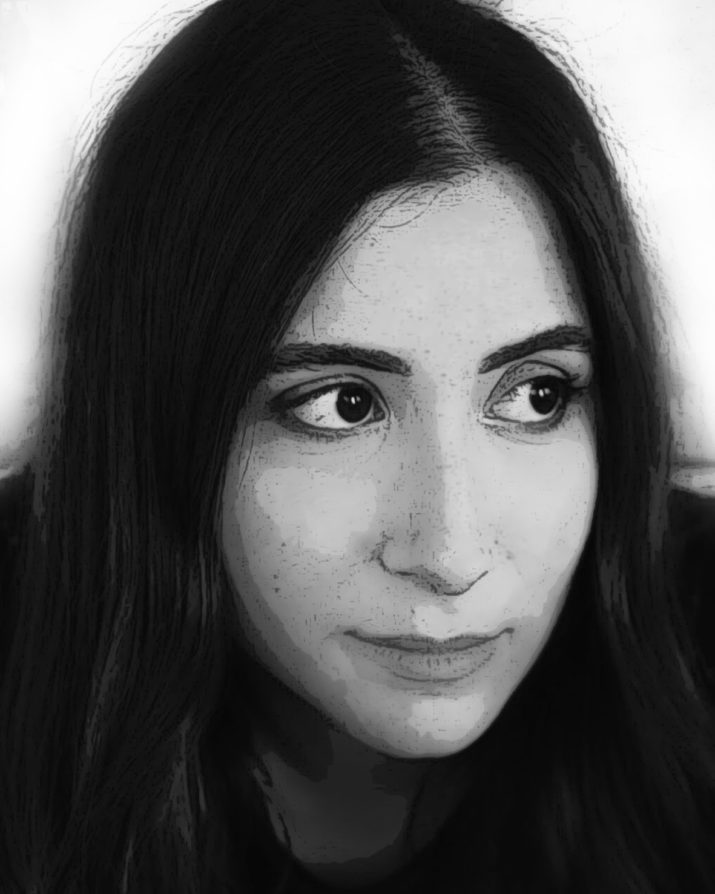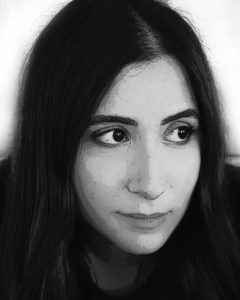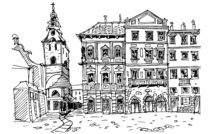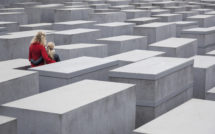

This is part of our special feature on Tourism: People, Places & Mobilities.
The stranger approached us slowly at first. I saw him walking, black hair in knots and a bottle with the cap open held by his side. He stopped by the stone steps leading up to the empty parking lot where we’d been standing for ten minutes. Leaning over the top, he brought his bottle, took a sip and stared at us.
“Is there a problem?”
“No, no problem,” we all said.
We were stuck in the parking lot. We’d just gotten back to Reykjavik from Jokulsarlon, driving around the streets trying to find a place to park so we could eat. We saw the parking lot, barrier up, and drove in. The barrier came down after us and we couldn’t leave. It was, as a waiter from the nearby Lobsterhouse told us, the faculty parking lot for the local school.
He smiled and shook his head as we all apologized for our mistake. There’s an Icelandic saying, he said, there’s no good luck without bad luck. He walked back to the restaurant to call the police for help as we stood by the barrier and laughed. Shortly after, two teachers walked to the only other car in the lot and we begged them for help. My brother-in-law Elliot got back in our car and followed theirs outside and parked on the curbside.
“What are you doing here?” the stranger asked.
“We got stuck in the lot but it’s fine now.”
The stranger shook his head. My sister Leyla and I tried not to stare at his bright blue eyes.
“How stupid can you be?” he said.
“Not…stupid…it was just a mistake,” I said.
“No, it is just stupidity,” he said.
He looked at each of us, took a sip from his bottle.
“So what are you doing, have you been traveling around Iceland?”
“Yes,” my sister said, “We just got back from Vik.”
“What is your favorite part of this trip so far?” he asked.
We each told him various things; the glacier lagoon in Jokulsarlon, the black sand beach in Vik, the puffin lookout in Westman Islands. He asked my sister if she got caught in the waves at the beach (it was his favorite place), and she said yes. He then turned to Elliot and scoffed.
“The Westman Islands, the people there are shit. The volcano should’ve gotten rid of them all in the 70s. But tourists are shit too, I hate them.”
“Yes,” we all said, smiling, “we hate them too.”
***
The first time I went to Iceland in March 2015, I saw the Northern Lights. I saw the Golden Circle, Thingvellir Park, and drove to Vik, fitting in each waterfall along the way in just five days. This time it was August 2017, we had ten days, and the sun wouldn’t set until 11:30pm, and even then, the pink, purple, and red hues remained in the sky for another hour, and I knew it would be easy to go mad here.
We didn’t race against time to hike up the sides of Svartifoss, the dark lava columns breaking off in hexagons as the falling water wears the edges down, or walk along the side of the Fjadrargljufur canyon, spotting black sheep across the crevices, listening to the water climb above rocks in the shallows and counting the green shades of moss.
We spent hours in Jokulsarlon, the glacier lagoon. In March, the broken pieces of ice were far from the shoreline and it was too cold to walk around the lake. This time, I could see the shades of turquoise and blue in the ice, fragmented by dark, lined cracks, as if the water below, the glacier behind, and the sky above all met within the floating frozen water.
This time, we made it to the other side of the black sand beach in Vik. I climbed up the basalt sea stacks in Reynisdrangar and jumped over rocks to get closer to the volcanic formations in the water just a small distance away from the shoreline.
This time, the land around the waterfall, Gulfoss, was green and bare, not yet frozen over. We walked to the top as the water and steam veiled our faces.
This time, we made it down the Thrihnukagigur volcano, taking an open elevator down into the empty magma chamber and running our hands over the walls, which were made colorful by minerals like copper, iron, and carbonate.
But at each of these sites we were not alone–the way we were on our first trip. I thought it was because of the season, that we had chosen the warmest time to come to Iceland and the masses of people surrounding the falls, taking boat tours on the lagoon, climbing over railings to get closer to the canyon, and walking in long lines across the lava fields to get to the volcano, simply happened to all be there at the same time. Yet, there was a change in the air, an intrusion I had not felt before when standing before these landscapes, these geological wonders, things I still fail to describe, things I would go back to if given the opportunity.
There were more people, more people bringing in their languages, their loud voices, their messes, and marking the ground. What once felt like a secret planet was now popular. Everything was changing.
***
His name was Gudmundur Ingi Thorvaldsson. He was our guide, leading us across the lava field to get to the dormant volcano Thrihnukagigur, just outside Reykjavik.
Our little group had people of all ages, so he would stop every once in a while, gathering us in a circle around small caves in the ground, as we stood on piles of dried lava that resembled the bones of dinosaurs.
He told us the tale of the volcano tours, how the site was only recently opened to tourists, and the entire process of convincing the municipalities and politicians to allow such a tour to exist took over two years. They were now in their fifth season, but elections were coming up and they would have to get new licenses.
I could see the volcano in the distance. The sun was bright but it was raining every few minutes.
“There is a potential plan,” Gudmundur began. “To create a road that leads up here, drilling a hole into the volcano so it is accesible to the old and handicapped, and open all year round. But it‘s too risky, this area is too unique, the only magma chamber you can enter in the world.”
The group murmured in agreement. A big part of the tour was the walk itself; a pilgrimage to the mountain.
“Let’s contine,” he said. “In my five years of experience, the people who walk deserve the volcano more than those who fly in with their helicopters.”
***
My brother-in-law Elliot likes doing things the hard way. Maybe that‘s why he decided that instead of taking a bus across Heimaey, the largest island in the Westman archipelago, we would walk two hours to get to the puffin lookout.
The walk to the side of the cliff, where the puffins nested, curved through the island, sometimes uphill or downhill, paved roads through a suburb, highways passing sheep and horses. I was in the throes of a sinus infection, so had to walk a bit slower than my normal pace. But the air I was breathing, the scent of the waves, the slight wind that picked up whenever we turned, kept me going.
We were just in viewpoint of the cliffs when we came across a headstone detailing the slave raids by Ottoman or “Barbary” pirates that took place in Iceland in 1627. The headstone stood just off the opposite side of the lookout. My sister and I laughed, damning our Turkish heritage.
We hiked up to the lookout just as a group of British teenagers left. We’d been lucky so far, arriving at our destinations just as large tour buses departed.
There was a little shack you could sit in to watch the puffins, but my sister and I slid down the right side of the cliff and dug our heels into the soft soil as we finally saw the hundreds of tiny puffins flying, squeaking, diving into the water below and sitting together just a few feet away from where we stood. Their large black eyes with glowing red-orange orbital rings and black crowns caught the light as they moved their heads around in front of us. Some sat in groups, others alone, some down in the crevices of the cave. My sister and I then hiked to the other side of the shack, inching closer and closer to the puffins, ducking down to keep from bothering them.
A couple who had been on the ferry with us over from Vik approached behind us.
“If it‘s their mating season don’t get too close, you’ll scare them off,” the man said. His long white beard concealed his face and his large camera hung clumsily from his neck.
My sister and I turned around but didn’t respond. Disturbing the puffins was definitely not our intention, nor was it up to the old man to make remarks.
We took a few more photographs, then met with Elliot and the other two friends who had come with us on the trip. We walked down the side of the cliff and made our way, another two hours, back to the center of town
It had been another pilgrimage, another sight we had to earn the right to witness. And for just a few minutes, we had been alone.
***
I’d heard that tourists would camp illegally in public places, defecate without cleaning up after themselves, cross clearly designated paths and potentially damage the vulnerable nature in the areas.
We saw a group of people cross the roped off wooden path by the canyon and walk to the uneven, crumbling edges to pose for photos. People threw coins into the hot springs in the Geysir area, kneeled far too close to the scalding streams of water and abused the portable toilet stalls in every popular tourist location, that were not in place when I’d first come to Iceland two years ago.
We forget that even though Iceland is relatively easy to reach now, most of the country is untamed. Citizens’ homes are restricted to a narrow ring of land around the coast, while the center ranges from rocks, ice, glaciers, and mossy flatlands. Signs follow you from the parking lot right up to the shore of the Reynisfjara beach, warning visitors of “sneaker waves,” large coastal waves that appear in a wave train with no warning and have dragged several tourists into the sea over the years, and yet we still saw people walking to the water, turning their backs to the sea.
Our little group began to repeat “never turn your back to the sea,” like a mantra. Don’t test nature, don’t leave any evidence you were there.
***
Our volcano guide, Gudmundur, divided us into groups of seven, and my sister, our two friends, and I were in the first group to be lowered into the volcano.
A steel elevator inched down a narrow hole at the top, and in six minutes, brought us to the base of the magma chamber. Water dripped from the rocks above as a small sliver of light shone down in a column. The walls of purple, dark red, black, orange, and gray towered above us. We were inside the earth.
We followed the roped trail around the chamber and then sat on large, dewy rocks, staring.
Gudmundur stood by the elevator’s drop off point, doing push-ups and planks to stay warm in the cold atmosphere, 120 meters down.
I decided to talk to him, and within minutes he chronicled the rise of tourism in Iceland, and what it means for him not only as a tour guide, but as an Icelander.
In 2008, three major private banks in Iceland defaulted in their debt and Iceland’s banking system collapsed, the stock market plunged and the country entereed a depression. The Icelandic króna lost value against the U.S. dollar, and the collapse made international news. The cheap currency began to attract travelers, while at the same time, Icelandair moved from serving domestic flyers to foreign ones. In April 2010, the Eyjafjallajökull volcano erupted, the ash clouds stopping flights across Europe for weeks. Suddenly, everyone knew about Iceland, journalists scrambled to report on the aftermath of the eruption and witnessed the extreme landscape of the country.
“Tourists saved Iceland,” Gudmundur said, his breath visible in the partially illuminated volcano we all stood inside.
“You have to be creative now. We cannot remain so isolated, we have been for a thousand years.”
The elevator went up, signaling our departure for the next time it came back down.
Gudmunder scratched his beard. He firmly believed that Iceland had always depended on others—it was a fact of modern life, a fact of survival, and so resentment towards the industry of tourism saving the country was ridiculous. The tension exists between those who embrace tourism and the new jobs it creates, and those who have been left behind or believe tourism is a pressure on Icelandic culture. The rush of foreigners and new cultures forces Iceland to think of what kind of country they want to be, how they want to present themselves, what parts of their home they want to share with others, and what parts they want to preserve. All municipalities have to designate spots for tourists, they have to create infrastructure to protect the environment and keep people safe, and perhaps they need to regulate key tourism routes and spaces, even though currently, the Icelandic government does not tax or charge visitors for entering the country and seeing national parks.
The elevator came down and he called out to the rest of our group.
We attached ropes to our harnesses, connecting to the sides of the elevator, and I looked down as we ascended. We walked down to the second base camp and ate warm stew and drank coffee.
Gudmundur approached me again before we left, reiterating the importance of being creative in Iceland.
“Look at what I do,” he said. “I love it. I share this with people all over the world.”
***
Back in the parking lot, the stranger turned to me.
“So you liked the glacier lagoon?”
“Yes, its my favorite. I love the blue in the ice.”
“Were there many people there?”
“No, no,” we all said. “We manage to avoid other people. We’re lucky.”
The stranger nodded, told us to enjoy the rest of our time, and started walking up the street. The police car the waiter had called for us approached. The stranger put his bottle, now a half empty Captain Morgans, underneath his blazer.
Mina Hamedi grew up in Istanbul, Turkey and is of Turkish/Iranian descent. She holds a B.A. from NYU’s Gallatin School of Individualized Study and an M.F.A. in Nonfiction from Columbia University School of the Arts. She loves to travel–amongst her many adventures her favorites include watching the Northern Lights in Iceland, chasing lemurs in Madagascar and exploring fairy chimneys in Cappadocia. Mina is currently writing a collection of essays that begin with her grandfather, spanning over four generations, and closely examining the influence of the world on her family.
Photo: Mina Hamedi, Private
Published on September 6, 2017.




